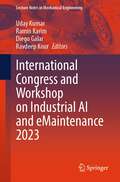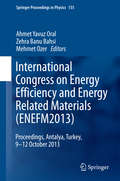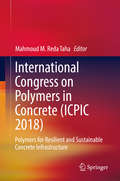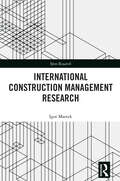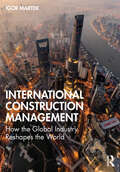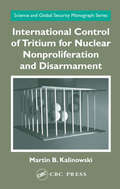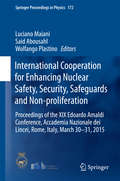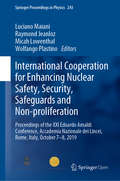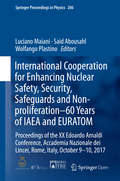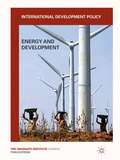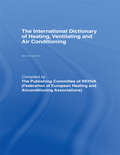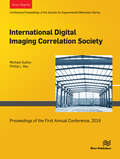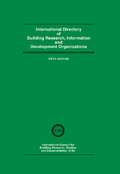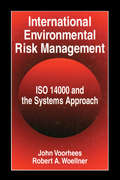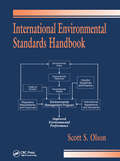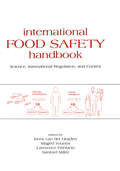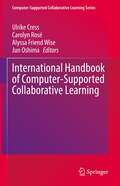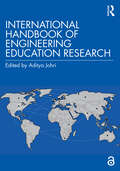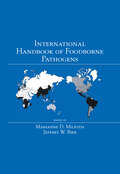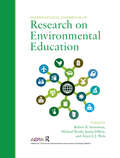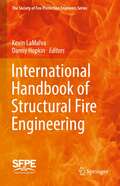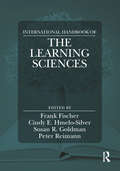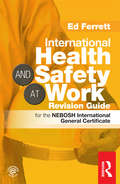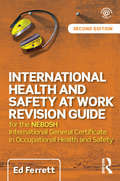- Table View
- List View
International Congress and Workshop on Industrial AI and eMaintenance 2023 (Lecture Notes in Mechanical Engineering)
by Uday Kumar Diego Galar Ramin Karim Ravdeep KourThis proceedings brings together the papers presented at the International Congress and Workshop on Industrial AI and eMaintenance 2023 (IAI2023). The conference integrates the themes and topics of three conferences: Industrial AI & eMaintenance, Condition Monitoring and Diagnostic Engineering Management (COMADEM) and, Advances in Reliability, Maintainability and Supportability (ARMS) on a single platform. This proceedings serves both academy and industry in providing an excellent platform for collaboration by providing a forum for exchange of ideas and networking. The 21st century has seen remarkable progress in Artificial Intelligence, with application to a variety of fields (computer vision, automatic translation, sentiment analysis in social networks, robotics, etc.) The IAI2023 focuses on Industrial Artificial Intelligence, or IAI. The emergence of industrial AI applications holds tremendous promises in terms of achieving excellence and cost-effectiveness in the operation and maintenance of industrial assets. Opportunities in Industrial AI exist in many industries such as aerospace, railways, mining, construction, process industry, etc. Its development is powered by several trends: the Internet of Things (IoT); the increasing convergence between OT (operational technologies) and IT (information technologies); last but not least, the unabated fast-paced developments of advanced analytics. However, numerous technical and organizational challenges to the widespread development of industrial AI still exist. The IAI2023 conference and its proceedings foster fruitful discussions between AI creators and industrial practitioners.
International Congress on Energy Efficiency and Energy Related Materials (ENEFM2013)
by Ahmet Yavuz Oral Mehmet Ozer Zehra Banu BahsiThe International Congress on Energy Efficiency and Energy Related Materials (ENEFM2013) was held on 9-12 October, 2013. This three-day congress focused on the latest developments of sustainable energy technologies, materials for sustainable energy applications and environmental & economic perspectives of energy. These proceedings include 63 peer reviewed technical papers, submitted from leading academic and research institutions from over 23 countries, representing some of the most cutting edge research available. The papers included were presented at the congress in the following sessions: General Issues Wind Energy Solar Energy Nuclear Energy Biofuels and Bioenergy Energy Storage Energy Conservation and Efficiency Energy in Buildings Economical and Environmental Issues Environment Energy Requirements Economic Development Materials for Sustainable Energy Hydrogen Production and Storage Photovoltaic Cells Thermionic Converters Batteries and Superconductors Phase Change Materials Fuel Cells Superconductors
International Congress on Polymers in Concrete (ICPIC #2018)
by Mahmoud M. TahaThis volume collects the proceedings from the International Congress of Polymers in Concrete 2018 (ICPIC), held under the theme “Polymers for Resilient and Sustainable Concrete Infrastructure.” ICPIC 2018 provides an opportunity for researchers and specialists working in the fields of polymers to exchange ideas and follow the latest progress in the use of polymers in concrete infrastructure. It also showcases the use of polymers and polymer concrete in sustainable and resilient development, and provides a platform for local and overseas suppliers, developers, manufacturers and contractors using polymers, polymer concrete and polymer composites in concrete structures to develop new business opportunities and follow the latest developments in the field. The International Congress of Polymers in Concrete is an international forum that has taken place every three years for the last 40 years with the objective of following progress in the field of polymers and their use in concrete and construction. Following 15 successful congresses held in London (1975), Austin (1978), Koriyama (1981), Darmstadt (1984), Brighton (1987), Shanghai (1990), Moscow (1992), Oostende (1995), Bologna (1998), Honolulu (2001), Berlin (2004), Chuncheon (2007), Funchal (2010), Shanghai (2013) and Singapore (2015), the 16th ICPIC will take place in Washington, DC, from April 29 to May 1st, 2018.
International Construction Management Research (Spon Research)
by Igor MartekThis book lays out the evolution of the often contested construction management discipline. How is the field defined? What has been discovered to date? Who are the researchers involved? Where is the research being conducted? What national priorities exist among the many nations now grappling with how to absorb foreign construction expertise, or compete in the global commons? Despite the overwhelming economic and political importance of the global construction industry and its impact on the world, until now, there has been no book dedicated to describing the body of research in the field, or where the knowledge frontier lies.This book is the first of its kind, offering a comprehensive appraisal of the state of play in the emerging field of international construction management (ICM) research. It will serve as a reference guide for academics and researchers embarking on or already active in global construction management research. It lays out who the researchers are, along with their fields of expertise, the institutions dedicated to ICM research, global research trends, the journals accepting ICM research, and a country-by-country analysis of national research priorities. It will assist the fledgling PhD and the budding researcher, as well as the discipline expert, in making better decisions on how to advance the field of international construction management through research that both augments CM education and directly benefits the industry.
International Construction Management: How the Global Industry Reshapes the World
by Igor MartekThis book tells you everything you need to know about international construction: the companies, their markets, the types of projects they build, how they compete and operate and how it affects us all. It paints a comprehensive portrait of an overlooked global business that generates a major portion of the GDP in every developed nation. As with any mature sector, countries make efforts to export their expertise, but the competition in construction is fierce, and the risks are many. Only the leanest and meanest survive. What, then, does it take to win? Most writing on construction focuses at the project-management level or even more narrowly at the level of technical performance. This book presents the big picture; it tells you what successful international construction companies do to stay in the game and thrive. The book examines international construction through three lenses. The first is theory. The body of existing knowledge on construction is here brought together, condensed and explained. The second are the actors. The companies that lead the way in global construction are showcased, and the features that make countries desirable hosts are appraised. Finally, what is it that firms actually do? This last part delves into the various strategic approaches taken by 60 construction firms in carving out and defending an overseas market niche. The insights provide guidance on how global construction companies develop competitive advantage and stay resilient in the face of a mercurial global economy. These lessons will be of interest to the student and manager alike.
International Control of Tritium for Nuclear Nonproliferation and Disarmament (Science and Global Security Monograph Series)
by Martin B. KalinowskiTritium is used by all nuclear weapons states to increase the explosive yield of atomic bombs and to miniaturize them. However, this radioactive material has not yet been put under appropriate international control comparable to the nuclear safeguards applied for plutonium and uranium. It is a neglected material in efforts to control the spread and
International Cooperation for Enhancing Nuclear Safety, Security, Safeguards and Non-proliferation
by Luciano Maiani Said Abousahl Wolfango PlastinoThis book, comprising contributions presented at the XIX Edoardo Amaldi Conference, examines important aspects of international cooperation aimed at enhancing nuclear safety, security, safeguards (the "3S"), and non-proliferation, thereby assisting in the development and maintenance of the verification regime and progress toward a nuclear weapon-free world. The Conference served as a forum where eminent scientists, diplomats, and policymakers could compare national perspectives and update international collaborations. The book opens by addressing the political, institutional, and legal dimensions of the 3S and non-proliferation; current challenges are discussed and attempts made to identify possible solutions and future improvements. Subsequent sections consider scientific developments that can contribute to increased effectiveness in the implementation of international regimes, particularly in critical areas, technology foresight, and the ongoing evaluation of current capabilities. The closing sections discuss scientific and technical challenges to the effective implementation of the 3S approach and the role of international cooperation and scientific community actions in leading the world toward peace and security.
International Cooperation for Enhancing Nuclear Safety, Security, Safeguards and Non-proliferation: Proceedings of the XXI Edoardo Amaldi Conference, Accademia Nazionale dei Lincei, Rome, Italy, October 7–8, 2019 (Springer Proceedings in Physics #243)
by Micah Lowenthal Luciano Maiani Wolfango Plastino Raymond JeanlozThis open access book examines key aspects of international cooperation to enhance nuclear safety, security, safeguards, and nonproliferation, thereby assisting in development and maintenance of the verification regime and fostering progress toward a nuclear weapon-free world. Current challenges are discussed and attempts made to identify possible solutions and future improvements, considering scientific developments that have the potential to increase the effectiveness of implementation of international regimes, particularly in critical areas, technology foresight, and the ongoing evaluation of current capabilities.
International Cooperation for Enhancing Nuclear Safety, Security, Safeguards and Non-proliferation–60 Years of IAEA and EURATOM: Proceedings Of The Xx Edoardo Amaldi Conference, Accademia Nazionale Dei Lincei, Rome, Italy, October 9-10 2017 (Springer Proceedings In Physics #206)
by Luciano Maiani Said Abousahl Wolfango PlastinoThis open access book examines key aspects of international cooperation to enhance nuclear safety, security, safeguards, and non-proliferation, thereby assisting in development and maintenance of the verification regime and fostering progress toward a nuclear weapon-free world. The book opens by addressing important political, institutional, and legal dimensions. Current challenges are discussed and attempts made to identify possible solutions and future improvements. Subsequent sections consider scientific developments that have the potential to increase the effectiveness of implementation of international regimes, particularly in critical areas, technology foresight, and the ongoing evaluation of current capabilities. The closing sections examine scientific and technical challenges and discuss the role of international cooperation and actions of the scientific community in leading the world toward peace and security. The book – which celebrates 60 years of IAEA Atoms for Peace and Development and the EURATOM Treaty – comprises contributions presented at the XX Edoardo Amaldi Conference, where eminent scientists, diplomats, and policymakers were able to compare national perspectives and update international collaborations.
International Development Policy: Energy and Development
by Marie ThorndahlInternational Development Policy: Energy and Development by Marie Thorndahl.
International Dictionary of Heating, Ventilating and Air Conditioning
by REHVAThe Dictionary is divided into two sections. The main sequence of the book consists of some 4,000 terms given in English, in alphabetical order, with their translations. The remainder of the book consists of alphabetical indexes for the other eleven languages covered: French, German, Italian, Danish, Finnish, Dutch, Spanish, Swedish, Hungarian, Polish and Russian. Each alphabetical index is keyed to serial numbers which refer the user to the correct item in the main sequence.
International Digital Imaging Correlation Society: Proceedings of the First Annual Conference, 2016
by Michael Sutton Phillip L. ReuThis collection represents a single volume of technical papers presented at the Annual International DIC Society Conference and SEM Fall Conference organized by the Society for Experimental Mechanics and Sandia National Laboratories and held in Philadelphia, PA, November 7-10, 2016. The volume presents early findings from experimental, standards development and various other investigations concerning digital image correlation - an important area within Experimental Mechanics. The area of Digital Image Correlation has been an integral track within the SEM Annual Conference spearheaded by Professor Michael Sutton from the University of South Carolina. In 2016, the SEM and Sandia joined their collaborative strengths to launch a standing fall meeting focusing specifically on developments in the area of Digital Image Correlation. The contributed papers within this volume span numerous technical aspects of DIC including standards development for the industry.
International Directory of Building Research Information and Development Organizations
by International Council for Building Research, Studies and DocumentationEvery entry follows a standard pattern: after the address and telephone number of the institution there is a brief description of its history and financial support, followed by the names of the senior staff, total number of staff, the institution's structure and services, its main research programmes and a list of its publications. For this new edition a subject index has been added, allowing the reader to identify centres of research activity on individual construction topics throughout the world. The world-wide investment in construction industry research is enormous. This unique directory is a guidebook to that investment which will enable its readers to isolate sources of advice on practical problems, information on national standards and requirements and potential research collaborators.
International Environmental Risk Management: A Systems Approach
by John Voorhees Robert A. Woellner Christopher L. BellBased on the first edition with extensive analysis of practical applications of environmental risk management and compliance management systems, this second edition of International Environmental Risk Management reflects updates made in the understanding and application of risk management best practices and makes available a frame of reference and systematic approach to environmental and social governance (ESG). It provides a pathway for readers to implement environmental management strategies that can be integrated with core operations and other risk management efforts, including supporting sustainability and corporate social responsibility initiatives associated with climate change, the circular economy or supply chain conditions, as well as enterprise risk management; anti-bribery, and other compliance management systems. This book provides in-depth discussions of ways to use global environmental management standards. New features in this edition: Combines EMS standards with discussion of specific principles, other authors’ research, and guidelines on management practices. Provides guidelines on how to prepare for, anticipate, and resolve environmental issues. Includes easily understandable information for all readers and is not simply aimed toward individuals who are knowledgeable about this topic. Provides in-depth discussions on using global environmental management standards to manage risk and promote resilience, as well as legal strategies and voluntary initiatives that companies can utilize to minimize risk. Accounts for the substantive revisions in ISO 14001:2015. As a growing and rapidly changing field, it is necessary to address new issues, guidelines, and regulations to assist businesses, academia, students, consultants, lawyers, and environmental managers with a pragmatic resolution to environmental risk management issues. This second edition gives a broad and detailed analysis of the changes made to international standards and practices and serves as an excellent guide to managing environmental risk.
International Environmental Risk Management: ISO 14000 and the Systems Approach
by John Voorhees Robert A. WoellnerInternational Environmental Risk Management: ISO 14000 and the Systems Approach gives readers an extensive analysis of practical applications of ISO 14000 and environmental compliance management systems. It offers a mixture of technical engineering advice, legal guidance, and common-sense business acumen. The authors explain the essentials of the standards - how they are being developed and what implications they present - and then discuss cost-benefit analyses, integration strategies, business risk control measures, litigation avoidance and legal expense reduction, and step-by-step guidance on achieving third-party certification.
International Environmental Standards Handbook
by Scott S. OlsonLack of knowledge about, and noncompliance with, international standards can result in loss of sales and partnership opportunities as well as possible legal action. The International Environmental Standards Handbook provides the necessary historical background to understand the current status of international environmental standards. It contains copies of available treaties and provides coverage of laws and standards. The book offers strategies for designing and implementing environmental systems that will be internationally accepted. It includes a list of information sources and a directory of international environmental organizations.
International Food Safety Handbook: Science, International Regulation, and Control
by Kees Van der HeijdenCovers all aspects of food safety--science, regulation, and labeling requirements--integrating major developments in the fields of toxicology, analytical chemistry, microbiology, hygiene, and nutrition. Designed to be a reference that bridges the gaps between science, regulation and control of food safety. While this might have been a rather ambitious aim, in putting together this book, the editors have certainly succeeded in gathering a group of experts from industry, government agencies, academia, consumer groups and the media whose knowledge and expertise reflect the complex and multisectoral/multidisciplinary nature of food safety." ---Food Science and Technology
International Handbook of Computer-Supported Collaborative Learning (Computer-Supported Collaborative Learning Series #19)
by Ulrike Cress Alyssa Friend Wise Carolyn Rosé Jun OshimaCSCL has in the past 15 years (and often in conjunction with Springer) grown into a thriving and active community. Yet, lacking is a comprehensive CSCL handbook that displays the range of research being done in this area. This handbook will provide an overview of the diverse aspects of the field, allowing newcomers to develop a sense of the entirety of CSCL research and for existing community members to become more deeply aware of work outside their direct area. The handbook will also serve as a ready reference for foundational concepts, methods, and approaches in the field. The chapters are written in such a way that each of them can be used in a stand-alone fashion while also serving as introductory readings in relevant study courses or in teacher education. While some CSCL-relevant topics are addressed in the International Handbook of the Learning Sciences and the International Handbook of Collaborative Learning, these books do not aim to present an integrated and comprehensive view of CSCL. The International Handbook of Computer- Supported Collaborative Learning covers all relevant topics in CSCL, particularly recent developments in the field, such as the rise of computational approaches and learning analytics.
International Handbook of Engineering Education Research
by Aditya JohriThis comprehensive handbook offers a broad overview of contemporary research on engineering education and its practical application. Over the past two decades, the field of engineering education research (EER) has become a vibrant and impactful community with new journals, conferences, and doctoral and research programs established across the globe. The increased interest in this area has helped improve the education and training of the next generation of engineers, as well as supporting growth in the use of technology for teaching and learning, increased attention to broadening participation, diversity and inclusion in the field, and a wide international expansion of the field. Drawing on the work of 100 expert contributors from over 20 countries, this volume covers both emergent and established areas of research within engineering education, giving voice to newcomers to the field as well as perspectives from established experts. Contents include: Sociocognitive and affective perspectives on engineering education. Technology and online learning in engineering education. Cultural and ethical issues including diversity, equity, and inclusion in engineering education. Curriculum design, teaching practices, and teacher education at all levels. Research methods and assessment in engineering education. This book offers an innovative and in-depth overview of engineering education scholarship and practice, which will be of use to researchers in engineering education, engineering educators and faculty, teacher educators in engineering education or STEM education, and other engineering and STEM-related professional organizations. The Open Access version of this book, available at http://www.taylorfrancis.com, has been made available under a Creative Commons Attribution-Non Commercial-No Derivatives (CC-BY-NC-ND) 4.0 license.
International Handbook of Foodborne Pathogens
by Marianne D. Miliotis Jeffrey W. BierThis reference describes the management, control, and prevention of microbial foodborne disease. It analyzes transformations in the epidemiology of foodborne disease from increased transnational food exchange to examinations of new and emerging zoonoses. It also discusses the prevalence and risk of foodborne disease in developing and industrialized
International Handbook of Research on Environmental Education
by Justin Dillon Robert B. Stevenson Michael Brody Arjen E.J. WalsThe environment and contested notions of sustainability are increasingly topics of public interest, political debate, and legislation across the world. Environmental education journals now publish research from a wide variety of methodological traditions that show linkages between the environment, health, development, and education. The growth in scholarship makes this an opportune time to review and synthesize the knowledge base of the environmental education (EE) field. The purpose of this 51-chapter handbook is not only to illuminate the most important concepts, findings and theories that have been developed by EE research, but also to critically examine the historical progression of the field, its current debates and controversies, what is still missing from the EE research agenda, and where that agenda might be headed. Published for the American Educational Research Association (AERA).
International Handbook of Structural Fire Engineering (The Society of Fire Protection Engineers Series)
by Kevin LaMalva Danny HopkinThis Handbook is focused on structural resilience in the event of fire. It serves as a single point of reference for practicing structural and fire protection engineers on the topic of structural fire safety. It is also stands as a key point of reference for university students engaged with structural fire engineering.
International Handbook of the Learning Sciences
by Peter Reimann Frank Fischer Cindy E. Hmelo-Silver Susan R. GoldmanThe International Handbook of the Learning Sciences is a comprehensive collection of international perspectives on this interdisciplinary field. In more than 50 chapters, leading experts synthesize past, current, and emerging theoretical and empirical directions for learning sciences research. The three sections of the handbook capture, respectively: foundational contributions from multiple disciplines and the ways in which the learning sciences has fashioned these into its own brand of use-oriented theory, design, and evidence; learning sciences approaches to designing, researching, and evaluating learning broadly construed; and the methodological diversity of learning sciences research, assessment, and analytic approaches. This pioneering collection is the definitive volume of international learning sciences scholarship and an essential text for scholars in this area.
International Health & Safety at Work Revision Guide: for the NEBOSH International General Certificate
by Ed FerrettThis companion to the bestselling International Health and Safety at Work will help you prepare for the written assessments on the NEBOSH International General Certificate in Occupational Health and Safety (October 2009 specification). It provides complete coverage of the syllabus in bite-sized chunks and will help you learn and memorise the most important areas, with links provided back to the main International Health and Safety at Work text to help you consolidate your learning. This revision guide is written by an experienced lecturer who has spent many years helping students become accredited by NEBOSH. Ed Ferrett is former Vice Chairman of NEBOSH (1999-2008) and a lecturer on NEBOSH courses with both public and private course providers. He is a Chartered Engineer and Health and Safety Consultant.
International Health and Safety at Work Revision Guide: for the NEBOSH International General Certificate in Occupational Health and Safety
by Ed FerrettThis companion to the bestselling International Health and Safety at Work is an essential revision aid for students preparing for their written assessments on the NEBOSH International General Certificate in Occupational Health and Safety. Fully updated to the April 2015 specification, the revision guide provides complete coverage of the syllabus in bite-sized chunks, helping readers to learn and memorise the most important topics. Throughout the book, the guide links back to the International Health and Safety at Work textbook, helping students to consolidate their learning. · Small and portable making it ideal for use anywhere: at home, in the classroom or on the move · Suggests useful tips on study and examination technique · Includes practice questions and answers based on NEBOSH exam questions · Everything you need for productive revision in one handy reference The International Health and Safety Revision Guide, written by the renowned health and safety author and former NEBOSH Vice Chairman Ed Ferrett, will be an invaluable tool for students as they prepare for their NEBOSH exam and for their subsequent health and safety work.
